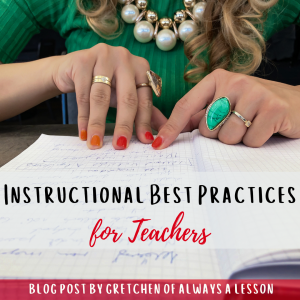Instructional Best Practices for Teachers
Teachers should receive ongoing professional development (PD) for current instructional best practices. This ensures they continue to grow as professionals, performing at higher rates in the classroom, which also has a positive effect on student achievement.
 What to Focus On
What to Focus On
There are many instructional strategies teachers should employ when instructing students. However, two that have had a tremendous impact on student understanding and achievement, are asking higher order thinking questions and increasing student ownership in the classroom.
Teachers need to learn how to effectively form and ask higher order questions, both during the lesson design phase and live in front of students. This helps increase critical thinking skills in students while solidifying new knowledge in long-term memory. This life skill is not isolated to a specific grade or subject area, rather a way in which students grasp new material during learning experiences. (Grab tips for Asking Higher Order Thinking Questions in the Classroom.)
When teachers learn how to better facilitate learning, they can begin to pass ownership to students in areas such as material distribution, movement transitions, activity directives, etc. This builds motivation to learn because students feel valued as responsible individuals. When students help run the classroom, they are more invested in the learning process. (Grab tips for Increasing Student Ownership in the Classroom.)
How to Provide Learning Opportunities to Teachers
Most of the time, teacher leaders (instructional coaches, curriculum coordinators, etc.) provide PD to teachers. These PD sessions should equip teachers with instructional best practices and current pedagogy knowledge. It’s best if they are ongoing, aligned to school goals, and build off each previous session. (Grab tips forLeading Efficient and Engaging PD Sessions for Teachers.)
Teacher leaders and administrators don’t have to be the only ones providing learning opportunities to teachers. Teachers themselves can share their strengths with their colleagues by observing one another live in front of students. It’s a low pressure, highly motivating experience since teachers respect one another’s expertise. (Grab tips for Learning Walks: Peer Observations.)
Most importantly, teachers can’t just consume information and haphazardly implement it into their practice. Teacher leaders need to provide teachers with feedback that is clear and bite-sized so that it can be applied immediately.[bctt tweet=”The follow-up after learning is just as important as the learning itself.” username=”gschultek”] (Grab tips for Creating a Feedback System for Teachers.)
It’s essential teachers engage in ongoing learning opportunities on current best practices to grow their craft. These learning opportunities should come in a variety of formats to help new learning stick and encourage teachers to continue growing. The suggestions in this post will empower educators in your school building.
GO BE GREAT!
What instructional best practices would you add to the list?


 Get Edu-Tips, Freebies and grab your FREE Study Guide for Gretchen’s New Book!
Get Edu-Tips, Freebies and grab your FREE Study Guide for Gretchen’s New Book!